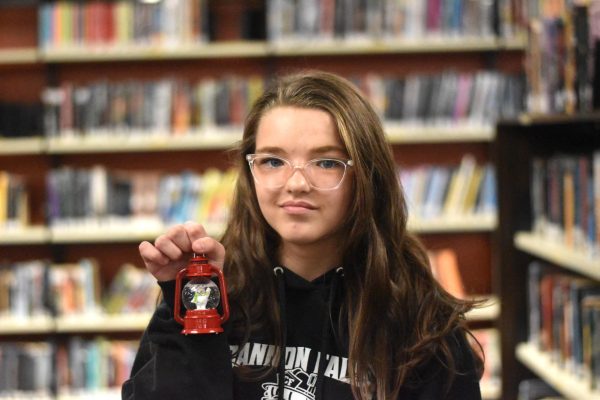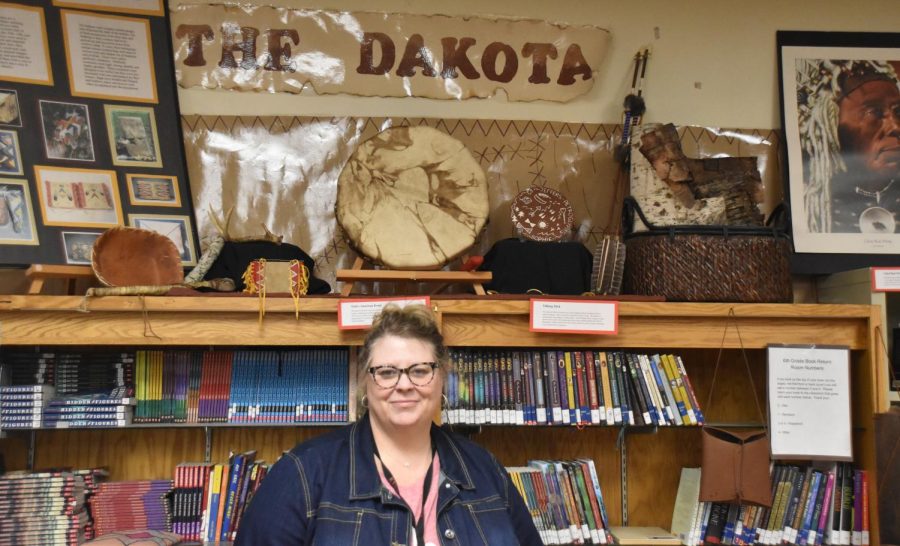Fun facts about artifacts
Ms Klapperich stands in front of many of the artifacts she has gathered in her classroom throughout the years
Mrs. Klapperich has a lot of artifacts to teach about. All these special artifacts have a story with a special meaning. Why shall one teacher have all these artifacts? Mrs. Klapperich took years collecting these artifacts; some of these items date back to the 1700s, and each one comes with a special history to teach. All of these stories are one of a kind.
[infographc credit=”” align=”left”] [/infographic]
Mrs Klapperich has a lot of artifacts to teach about. All these special artifacts have a story with a special meaning. Why shall one teacher have all these artifacts? Mrs Klapprich took years collecting these artifacts; some of these items date back to the 1700s, and each one comes with a special history to teach. All of these stories are one of a kind.
Ledger Art – Mrs. Klapperich picked this up at the Mille Lacs Indian Museum last time she was there. Ledger books were a common source of paper for the Plains Indians during the 1800’s Ledger art evolved from Plains hide painting when the buffalo became scarce. An increasing supply of ledger books and other paper came from traders, government agents, missionaries and military officers. With these came pencils, ink fountain pens, crayons and watercolor paints. The compact ledger books and pencils were highly portable, making them ideal for nomadic lifestyles. This particular piece is from artist Evans Flammond Sr, a respected Lakota artist.
Old Turtle – picture books are a great way to introduce people to other cultures. Mrs. Klapperich’s room has dozens of American Indian picture books that focus mostly on Dakota and Ojibwe cultures. This particular book, Old Turtle, was written by Minnesota author, Douglas Wood. It focuses on unity and the interconnectedness between humans and nature.
Ojibwe Shoulder Bag – these bags were based on bandolier bags carried by European soldiers . These bags were generally made by women, but worn by men. They were made out of trade cloth or hide and decorated with tiny glass beads called seed beads which were acquired through the fur trade. These glass beads replaced the previously used porcupine quills which were softened and dyed.
Talking stick – a talking stick, also known as a speaker’s staff, has been used for centuries to keep order at council meetings. Only one person speaks at a time and that speaker is determined by the talking stick. When in possession of the stick they are able to give their opinion without interruption. A time limit may be set to make sure there is fair representation of all opinions.
falo Horn Spoon – these spoons have been around as long as buffalo and people of the Plains have coexisted. They are made by cutting a buffalo horn down the middle. They were often decorated with beads and used for both everyday and ceremonial purposes.
Turtle Shell Rattle – This particular turtle shell rattle was made by an Ojibwe man near the Red Lake Reservation. It has a coyote leg handle with a band of beaver fur and deer hide strip. The rattles were traditional instruments of the Ojibwe people used to keep time and rhythm during ceremonies.
Fish Decoy – Ojibwe fishers have a long history of using hand carved decoys for spearfishing. The decoy was lowered into the water by a length of sinew and then manipulated to imitate the behavior of a bait fish. Once a muskie or other desired fish approached, a spear was thrown to secure the catch.
Birchbark – Dakota and Ojibwe living in Minnesota used bark from birch trees to make many things. They used it to cover their wigwams, make baskets and containers, make cones to hold maple sugar and it was even used to construct canoes. Because it is nearly waterproof, it was used to make pots for cooking. Either hot stones could be dropped in to heat the food, or it could be hung over a fire as long as it contained liquid.
Parfleche bags – these hide containers were used for a magnitude of purposes. They could be used to store food, clothing, tools or other important objects. They were easy to store inside the tipi and could be hung from the tipi poles. They were essential for the American Indian people who migrated with the seasons and could be stacked on a travois for moving.
Drum – Mrs. Klapperich actually made this drum herself. The hide was soaked in a dye made from black walnuts, stretched and finally secured on a frame. The drum is much more than a musical instrument to the Native cultures. It holds great cultural and symbolic power. They believe the drum has a life of its own as well as its own powerful spirit. It is considered the heartbeat of Mother Earth and calls the spirits and nations together.
Worry Basket – this basket was made by an Ojibwe artist from the Red Lake Reservation. He explained that the basket was to be set by the door of your home. When you left your home for the day you were to drop your worries into the basket so they wouldn’t accompany you throughout your day. Then, when you come home again, you were to drop any new worries into the basket so they wouldn’t interfere with special time spent with your family. The basket was to help you balance your life and recognize your priorities.
bone bead and lead shot – these two items are part of the fur trade display in Mrs. Klapperich’s room. The bone bead and led shot were both valuable trade items desired by the American Indian people in Minnesota. In exchange for pelts, European fur traders provided the Dakota and Ojibwe with goods that made their lives easier. Colorful beads, fabric, dyes, brass and tin kettles, axes, guns and other tools were life changing to the American Indian people.

Emilia Nelson, a mysterious young lady from Artemisia on the planet of Luna. The 3rd Trimester of the Plague broke through and she stole a ship and crashed...

